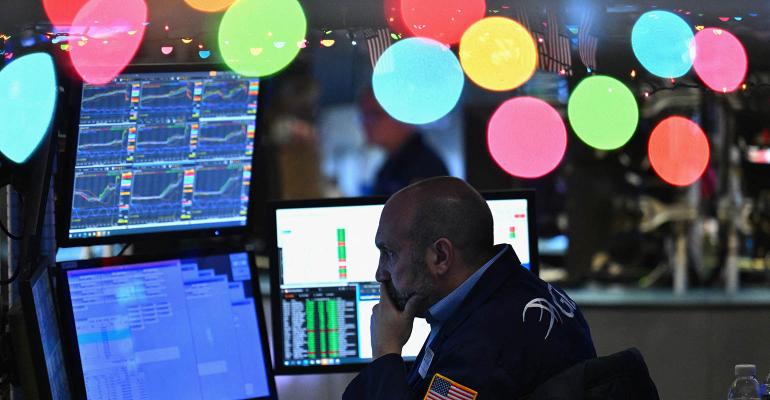(Bloomberg Opinion) -- Excited about 2024? US equity strategists sure aren’t. While none of them are projecting a big crash, per se, strategists’ average 2024 target price for the S&P 500 Index exhibits a collective inability to envision much upside over the next 12 months. History suggests that we should prepare for the possibility that they are underestimating the opportunity.
The S&P 500 would gain about 2.4% from its Dec. 21 close if it tracked the average forecast, a pessimistic outlook by historical standards. If you look at strategists’ year-end calls collected in early January of each calendar year since 2000, the average projection has implied an 8.3% upside, and there’s never been a time in the sample period when strategists projected a decline. With that context, the current call — for an only 2.4% increase — is just about as bad as it gets. If you believe the strategists, you’re better off putting your money in 12-month Treasury bills yielding 4.83% than taking your chances with stocks.
The “average” doesn’t do justice to the diversity of opinions out there. For 2024, the index targets stretch from JPMorgan Chase & Co. at 4,200 to Yardeni Research at 5,400, 28% higher. The trouble is, the track records of individual strategists tend to be even more spotty than the average. Many of the strategists who are taking victory laps today for their bullish 2023 calls also failed to foresee the big drawdown of 2022.
Okay, so is the average strategist outlook useful then?
It depends. The charitable response, on a very basic level, is that it usually gets the sign right at the start of the year. But that’s easy to do when you just predict gains every year! During the sample period, the market rose in two of every three years — consistent with the evidence that the market goes up more than it goes down.
Once you bring in other criteria, the performance gets even less impressive. The average point estimate at the start of the year regularly misses the actual outcome by a wide margin. But even tracking changes in the price target and actively trading off that (selling whenever the index rose above the strategist target, and buying when it fell below) translates into significant underperformance to a buy-and-hold strategy.
Of course, no one’s saying to take what strategists say and do the opposite, either. Clearly, they’re far from a perfect “contrarian indicator,” but it’s worth remembering that some of the index’s best runs have come in years when the strategist community failed to see the upside. Chalk some of that up to low expectations and the rest of it up to the fundamental unpredictability of markets and economies.
Among the S&P 500’s 10 best years since 2000, four came in periods during which the average strategist was projecting annual returns of under 5%. That includes 2013, the best year of the millennium, and 2023. In other words, it’s important to consider the possibility that the average strategist may be overly negative.
So what could go right in 2024? The bull case would see some combination of:
- Market leaders continuing to churn higher (perhaps through a combination of better-than-expected realized earnings and encouraging signals about the long-run potential from artificial intelligence.)
- Market laggards starting to catch up (fueled by waning recession fears and earnings recoveries in key cyclical categories.)
- And further declines in bond yields (which could continue to support high forward price-earnings multiples.)
In other words, the index would essentially need a “Goldilocks” economy to significantly beat expectations, which may qualify as wishful thinking — but it certainly feels possible given recent macroeconomic data.
Hobbyists in the investing game often think that risk mitigation is all about preparing for doomsday scenarios (loading up on T-bills or “protective put” options, for example, to guard against the next Great Depression or Black Monday). And to be sure, there are still plenty of good reasons to be on guard for a market swoon, including the non-negligible risk that the Fed’s 2022-2023 inflation fighting campaign will indeed start to push up unemployment to a more meaningful degree. In reality, of course, there’s also much risk in missing out on a great rally, and no one should assume it can’t happen just because the strategist class is exhibiting a rare failure of imagination.
More From Bloomberg Opinion:
- Fed, Markets Resume Unhealthy Co-Dependency: Mohamed A. El-Erian
- No Slump, Sherlock — Dogs That Didn't Bark in 2023: John Authers
- Ditching EM for the Magnificent Seven Is a Bad Idea: Shuli Ren
Want more Bloomberg Opinion? OPIN <GO>. Or you can subscribe to our daily newsletter.
To contact the author of this story:
Jonathan Levin at [email protected]





